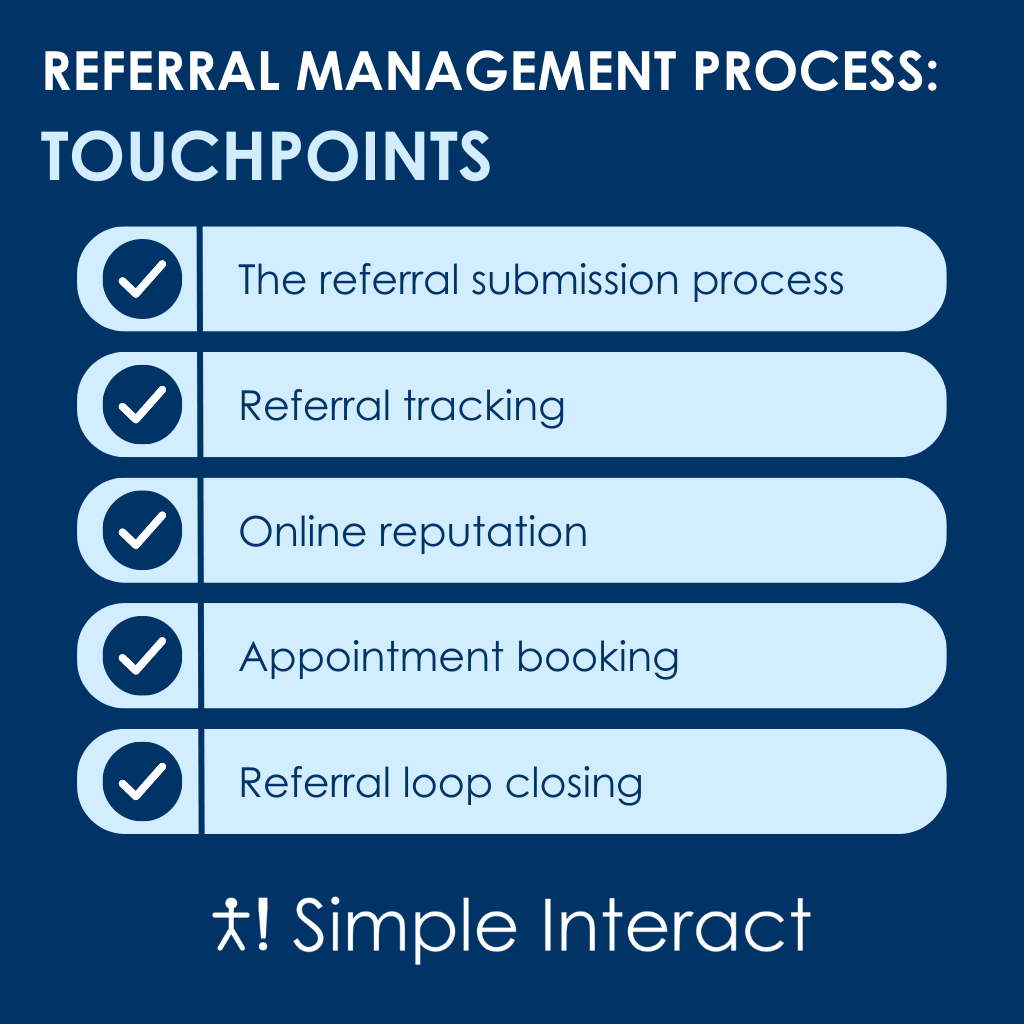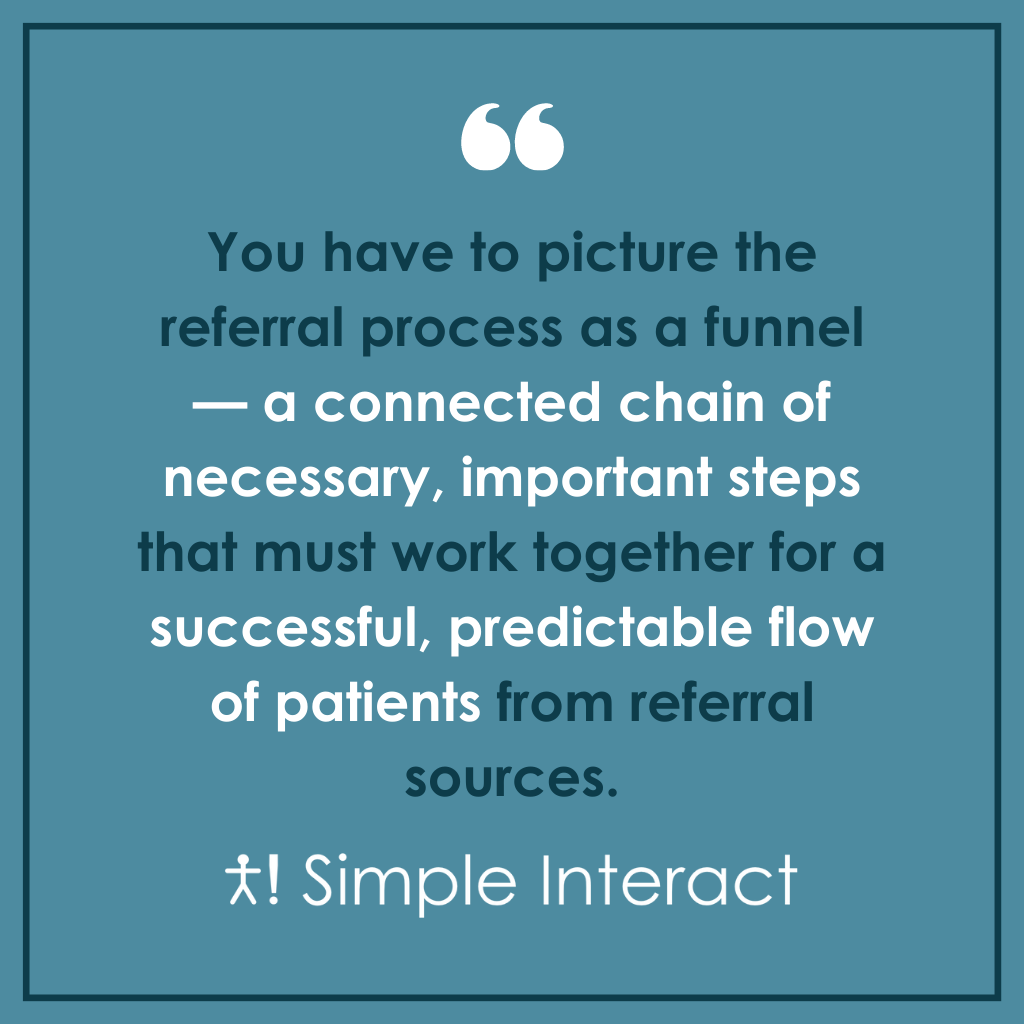How NOT to Lose Leads in Your Referral Management Process

At first glance, the referral management process may seem straightforward. You share your marketing materials with your referral source partners and inform them about what you do better than anyone else. Then you sit back and wait for the referrals to roll in.
While this marketing communication is a great first step, it’s not sufficient in and of itself.
When a practice starts referring patients to you, perhaps they discover that the process is cumbersome and takes too much of their staff’s time. Or, maybe they become frustrated when they don’t hear back about the status of a patient’s referral.
Or, perhaps patients have trouble booking with you, or they notice your 2.5-star rating on Google and ask their physician for an alternate referral.
Any one of these reasons will discourage referral sources from referring new patients to you in the future.
To prevent this, you have to picture the referral process as a funnel — a connected chain of necessary, important steps that must work together for a successful, predictable flow of patients from referral sources.
The referral management process includes many touchpoints in addition to marketing to referral sources:
- The referral submission process
- Referral tracking
- Online reputation
- Appointment booking
- Referral loop closing
Together, these parts make up the whole of referral management. If you focus solely on marketing, your referral sources will eventually lose interest and route referrals to partners with better referral management software and processes.
Instead, let’s talk about how to broaden our vision to address every touchpoint.

Why Every Touchpoint in the Referral Management Process Is Important
At the end of the day, your referral conversion rate is the metric that truly matters.
Focusing on only one link in the chain, regardless of what it is, won’t fix that final conversion rate. Rather, it creates a game of Whac-A-Mole. You get one touchpoint under control, and another pops up needing your attention as it drags the rate down from a different angle.
Below is a bird’s-eye-view of all the referral management touchpoints you can streamline to work seamlessly together and increase your referral conversion rate.
Marketing to Referral Sources
The first and perhaps most obvious step — marketing to referral sources — includes sharing compelling marketing materials with referral source partners so they know to send patients your way.
Suppose you’re a gastroenterologist who sends your marketing representative to a nearby family practitioner. The rep shares your marketing materials, which communicate who you are, what you offer, and why you’d be a great partner for the practice. Making sure those materials are dialed in gives you an excellent beginning.
One addition that could take your marketing to the next level might be including a QR code the practice can use to complete the referral submission process. This leads into the next step in the funnel.
Referral Submission Process
When distributing marketing materials, providing an easy-to-use, digital referral submission process (like a QR code) on a flyer or business card makes sending a referral to your practice less cumbersome.
When a patient comes to the primary care office with a GI issue requiring a specialist, the staff has a simple, accessible means of making the referral. They quickly scan the code, enter the patient’s information, and submit the referral through your referral management software. No phone calls, faxes, or messy paperwork.
Referral Tracking
Historically, referrals arrived via fax machine, and the office staff would scribble notes on the pages, such as when they tried to contact the patient or when to try again. As we all know, however, handwritten notes are hard to track and loose papers can get lost in the shuffle, especially if contacting a patient takes extra time.
Without a streamlined process to keep track of referrals, referrals can become stale and conversion rates can sink.
Good referral management software will offer a digital tracking dashboard, allowing your staff to monitor the status of every referral in one place. They should also be able to add notes, change statuses, reach out to patients about booking appointments, and contact the referral partner to acknowledge receipt (and say “thank you”).
Online Reputation
After you reach out to a referred patient, the patient will often investigate your online reputation. Even if they book an appointment with you during the initial phone call, they’ll quickly cancel if they discover your practice has a two-star rating.
A stellar online reputation (four or more stars) increases your chances of patients booking and keeping appointments with your facility.
Appointment Booking
Just like you need to make it easy for a referral source partner to send you referrals, you need to make it easy for patients to book their appointments. This is another place where good referral management software can help.
Instead of calling patients and keeping them on the phone to collect their information, your referral management software can send them a text or email message with a link for patients to request an appointment time and fill out all their details at their convenience.
Referral Loop Closing
The last step in the referral management process is closing the referral loop. This step involves contacting the referral source and updating them on pending or scheduled appointments, as well as letting them know when patients don’t qualify. This reinforces the relationship with your referral source partners and helps them send better referrals your way.

Increase Your Referral Conversion Rate With Simple Interact
If you want to increase your referral conversion rate, identifying each touchpoint in the referral management process is a great place to start. Once you identify targets to improve for each step (i.e., reducing referral submission time to two minutes, increasing your online rating to four or more stars, responding to referral submissions within 30 minutes, etc.), you can use your preferred framework — such as the OKR framework — to create action items to reach these targets and measure and track your progress.
If you would like to streamline the referral management process, please request a demo of Simple Interact’s referral management software solution. We can help you improve your referral conversion rate.

Ravi Kalidindi is the Founder and CEO of Simple Interact, a leading Front Office Automation company that helps healthcare facilities across the United States run more efficiently and profitably by boosting staff productivity, reducing provider burnout, and elevating the patient experience. Customers view Ravi as a trusted partner who can quickly comprehend business problems and suggest “keep it simple” solutions that are effective and easier to maintain over time.
Recent Posts
- The Benefits of Using 2-Way SMS Chat for Healthcare Communication
- 2-Way SMS vs. Live Chat: Which Is Best for Bi-Directional Patient Communication?
- Simple Interact Earns A+ Satisfaction Ratings in KLAS Report
- Boosting Healthcare Staff Productivity With a Shared Inbox Dashboard
- Healthcare SMS: What Metrics to Track in Your 2-Way SMS
Categories
Archives
- February 2025
- June 2024
- May 2024
- April 2024
- March 2024
- February 2024
- January 2024
- December 2023
- November 2023
- October 2023
- September 2023
- August 2023
- July 2023
- June 2023
- May 2023
- April 2023
- March 2023
- February 2023
- January 2023
- December 2022
- November 2022
- October 2022
- September 2022
- August 2022
- July 2021
- December 2020
- May 2020
- March 2020
- June 2016